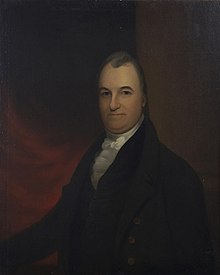Richard Stockton (senator)
Richard Stockton | |
|---|---|
 | |
| Member of the U.S. House of Representatives from New Jersey's 2nd district | |
| In office March 4, 1813 – March 3, 1815 Serving with James Schureman | |
| Preceded by | Adam Boyd Lewis Condict Jacob Hufty George C. Maxwell James Morgan Thomas Newbold |
| Succeeded by | Benjamin Bennet Henry Southard |
| United States Senator from New Jersey | |
| In office November 12, 1796 – March 3, 1799 | |
| Preceded by | Frederick Frelinghuysen |
| Succeeded by | Jonathan Dayton |
| United States Attorney for the District of New Jersey | |
| In office 1789–1791 | |
| President | George Washington |
| Preceded by | Office established |
| Succeeded by | Abraham Ogden |
| Personal details | |
| Born | April 17, 1764 Princeton, New Jersey, U.S. |
| Died | March 7, 1828 (aged 63) Princeton, New Jersey, U.S. |
| Political party | Federalist |
| Education | Princeton University (BA) |
Richard Stockton (April 17, 1764 – March 7, 1828) was a lawyer who represented New Jersey in the United States Senate and later served in the United States House of Representatives. He was the first U.S. Attorney for the District of New Jersey, holding that office from 1789 to 1791, and ran unsuccessfully for vice president in the 1820 election as a member of the Federalist Party, which did not nominate a candidate for president.
Life
Stockton was born in Princeton, New Jersey, the son of Richard Stockton, a signer of the Declaration of Independence.[1] He was tutored privately, and graduated from the College of New Jersey (now Princeton University) in 1779. He studied law, was admitted to the bar in 1784 and commenced practice in Princeton.
Stockton was a presidential elector in the 1792 and 1800 presidential elections.[2] He was elected as a Federalist to the United States Senate to fill the vacancy caused by the resignation of Frederick Frelinghuysen and served from November 12, 1796, to March 4, 1799, but declined to be a candidate for reelection. He was an unsuccessful candidate for Governor of New Jersey in 1801, 1803, and 1804. He was elected as a Federalist to the Thirteenth Congress, serving from March 4, 1813, to March 3, 1815, and declined to be a candidate for renomination to the Fourteenth Congress.
Stockton was elected a member of the American Antiquarian Society in 1815.[3]
After leaving Congress, he resumed the practice of his profession. He died at Morven, near Princeton, and was interred in Princeton Cemetery in Princeton.
Family
In 1788, Stockton married Mary Field (1766–1837).[4] They were the parents of nine children, including Mary Field, Richard, Julia, Robert Field, Horatio, Caroline, Samuel Witham, William Bradford, and Annis.[4]
His brother Lucius Horatio Stockton served as U.S. Attorney for the District of New Jersey.
His son Commodore Robert F. Stockton was the Military Governor of California who defeated the Mexican army in 1846. He later became a senator from New Jersey like his father before him.
His daughter Annis Stockton was the first wife of U.S. Senator John Renshaw Thomson.
References
- ^ "Office History". justice.gov. United States Department of Justice. 18 March 2015. Retrieved May 28, 2021.
- ^ The National Cyclopaedia of American Biography. Vol. II. New York, N.Y.: James T. White & Co. 1892. p. 7 – via Google Books.
- ^ American Antiquarian Society Members Directory
- ^ a b Bill, Alfred Hoyt (1954). A House Called Morven: Its Role in American History, 1701-1954. Princeton, N.J.: Princeton University Press. p. 70. ISBN 9781400874682.
External links
- United States Congress. "Richard Stockton (id: S000941)". Biographical Directory of the United States Congress.
- Biographical Directory of the United States Congress, 1774-2005: The Continental Congress, September 5, 1774, to October 21, 1788, and the Congress of the United States, from the First Through the One Hundred Eighth Congresses, March 4, 1789, to January 3, 2005, Inclusive. p. 1983 United States Congress. U.S. Government Printing Office, (2005) ISBN 9780160731761
- Richard Stockton (1764-1828) at The Political Graveyard
- Richard Stockton at Find a Grave

